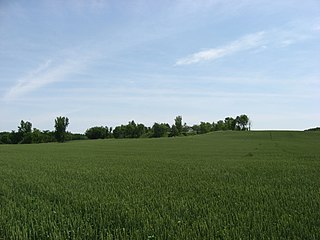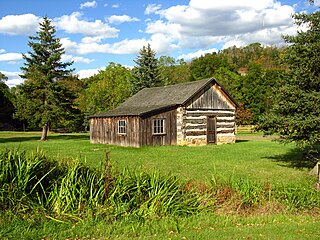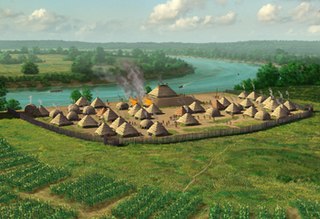Related Research Articles

The Glacial Kame Culture was a culture of Archaic people in North America that occupied southern Ontario, Michigan, Ohio and Indiana from around 8000 BC to 1000 BC. The name of this culture derives from its members' practice of burying their dead atop glacier-deposited gravel hills. Among the most common types of artifacts found at Glacial Kame sites are shells of marine animals and goods manufactured from a copper ore, known as float copper.

The Wesley Butler Archeological District is a historic district composed of a group of archaeological sites in the southwestern corner of the U.S. state of Ohio. Located south of Elizabethtown, the district comprises three Native American mounds and the site of a Native American village, spread out over an area of 40 acres (16 ha). Although the mounds are built atop part of the village site, they are not contemporaneous: the mounds were built by Woodland peoples, but the village dates from the far older Archaic period.

The Dravo Gravel Site (33HA377) is an archaeological site located above the Great Miami River in Miami Township, Hamilton County, Ohio, United States. Discovered in the middle of a gravel pit, the site is a leading example of the local manifestation of the Archaic period.

The Shawnee Lookout Archeological District is a historic district in the southwestern corner of the U.S. state of Ohio. Located southwest of Cleves in Hamilton County's Miami Township, the district is composed of forty-six archaeological sites spread out over an area of 2,000 acres (810 ha). Thirty-four of these sites are located in the 1,000-acre (400 ha) Shawnee Lookout Park, which has been called one of the most beautiful parks in southwestern Ohio.

The State Line Archeological District is a complex of archaeological sites and national historic district located west of Elizabethtown, Ohio, United States. Located on both sides of the Indiana/Ohio border, the historic district is composed of five contributing properties spread out across 8 acres (3.2 ha) of land. It is believed to have been the site of a village of the Fort Ancient culture of prehistoric Native Americans.

The Thunderbird Archaeological District, near Limeton, Virginia, is an archaeological district described as consisting of "three sites—Thunderbird Site, the Fifty Site, and the Fifty Bog—which provide a stratified cultural sequence spanning Paleo-Indian cultures through the end of Early Archaic times with scattered evidence of later occupation."

The Carl Potter Mound is a historic Native American mound in southern Champaign County, Ohio, United States. Located near Mechanicsburg, it lies on a small ridge in a pasture field in southeastern Union Township. In 1974, the mound was listed on the National Register of Historic Places as a potential archaeological site, primarily because of its use as a burial mound.

The Bedford Village Archeological Site (36BD90) is an archaeological site in central Bedford County, Pennsylvania, United States. Located in Bedford Township north of the borough of Bedford, it was once occupied by a Monongahela culture village. Today, the site is the location of Old Bedford Village, an open-air museum.

The Sommerheim Park Archaeological District includes a group of six archaeological sites west of Erie, Pennsylvania in the United States. The sites are in Sommerheim Park, one of the few undeveloped areas of the Lake Erie shoreline, in Millcreek Township. This district has been listed on the National Register of Historic Places. This is one of the leading archaeological sites in the Erie area and along the southern shoreline of Lake Erie, due to the amount of artifacts and the lack of disturbance on the site.

The Tudek Site is an archaeological site located near State College in Centre County, Pennsylvania, United States. Used as a stone quarry by prehistoric Native Americans ten thousand years ago, it has been recognized as a prime candidate for prehistoric preservation.
The Clarke Farm Site is an ancient archaeological site in the southwestern part of the U.S. state of Ohio. Located near Point Pleasant in Clermont County, it is a heavily stratified site, with nearly 8,000 years of occupation. Excavations at the site have yielded a large number of artifacts, including bones, chert, pottery, and shells. Cultures represented at the site range from Early Archaic to Fort Ancient, along with various Woodland cultures. The site encompasses an area of approximately 20 acres (8.1 ha), located along Big Indian Creek.
The East Fork Site is an archaeological site in the southwestern part of the U.S. state of Ohio. Located south of Batavia, it has yielded artifacts from more cultures than has any other site in Clermont County.
The Ufferman Site is an archaeological site in the central part of the U.S. state of Ohio. Located north of the city of Delaware, it occupies approximately 2 acres (0.81 ha) of land near Delaware Lake on property near to the boundaries of Delaware State Park. It appears to have been the location of a village of the Cole culture, which inhabited the region during the later portion of the Woodland period. Ufferman lies only 0.6 kilometres (0.37 mi) south of the W.S. Cole Site, the type site for the culture, and approximately 23 kilometres (14 mi) north of the Highbank Park Works, which are believed to have been built by peoples of the Cole culture.

The Cary Village Site is an archaeological site in the west-central portion of the U.S. state of Ohio. Located southeast of the village of Plain City in Madison County, the site occupies a group of grassy terraces located amid two farm fields. In this grassy area, archaeologists have discovered a wide range of artifacts, including stone tools, materials made of flint, and various types of pottery.

The LoDaisKa Site is a prominent archaeological site in the U.S. state of Colorado, located within a rockshelter near Morrison. The rockshelter was first inhabited by people of the Archaic through the Middle Ceramic period, generally spanning 3000 BC to 1000 AD.
The Ety Habitation Site is an archaeological site in the central part of the U.S. state of Ohio. Located northeast of the village of Carroll in Fairfield County, it encompasses an area of about 4 acres (1.6 ha), which is covered by a group of hillocks. Here have been found large numbers of artifacts of prehistoric man; the nature of the material found suggests that the Habitation Site was a substantial settlement for a long period, most likely from the Hopewellian period, two thousand years ago. Few Hopewellian sites have been discovered that both yielded such valuable information and were so little damaged by the passage of time; as a result, the Ety Habitation Site is a leading archaeological site.

The Bullskin Creek Site is an archaeological site in the southwestern portion of the U.S. state of Ohio. Located near Felicity in Clermont County, the site appears to have been a base camp for nomads during the Late Archaic period. The site comprises three loci: two significant areas of various debris and a large midden that underlies everything else. From these components, which cover an area of approximately 400 feet (120 m) by 600 feet (180 m), collectors and archaeologists have recovered hundreds of artifacts, including stone tools, weapons, and bone tools. Because the site is located in a farm field, it has frequently been cultivated, and the plow has brought at least five burials to the surface from a cemetery on the edge of the site. Among the types of features found at the site are ovens, trash pits, and postmolds. Bodies at the site were generally adorned with red ochre and buried in a flexed position.

The Hidden Valley Rockshelter (44-BA-31) is a significant archaeological site located near the community of Warm Springs in Bath County, Virginia, United States. A large rockshelter located near the Jackson River, it has been occupied by humans for thousands of years, and it has been named a historic site.

The Annis Mound and Village Site is a prehistoric Middle Mississippian culture archaeological site located on the bank of the Green River in Butler County, Kentucky, several miles northwest of Morgantown in the Big Bend region. It was occupied from about 800 CE to about 1300 CE.
References
- 1 2 3 "National Register Information System". National Register of Historic Places . National Park Service. March 13, 2009.
- ↑ 44 FR 7553
- 1 2 3 4 Owen, Lorrie K., ed. Dictionary of Ohio Historic Places. Vol. 1. St. Clair Shores: Somerset, 1999, 139-140.
